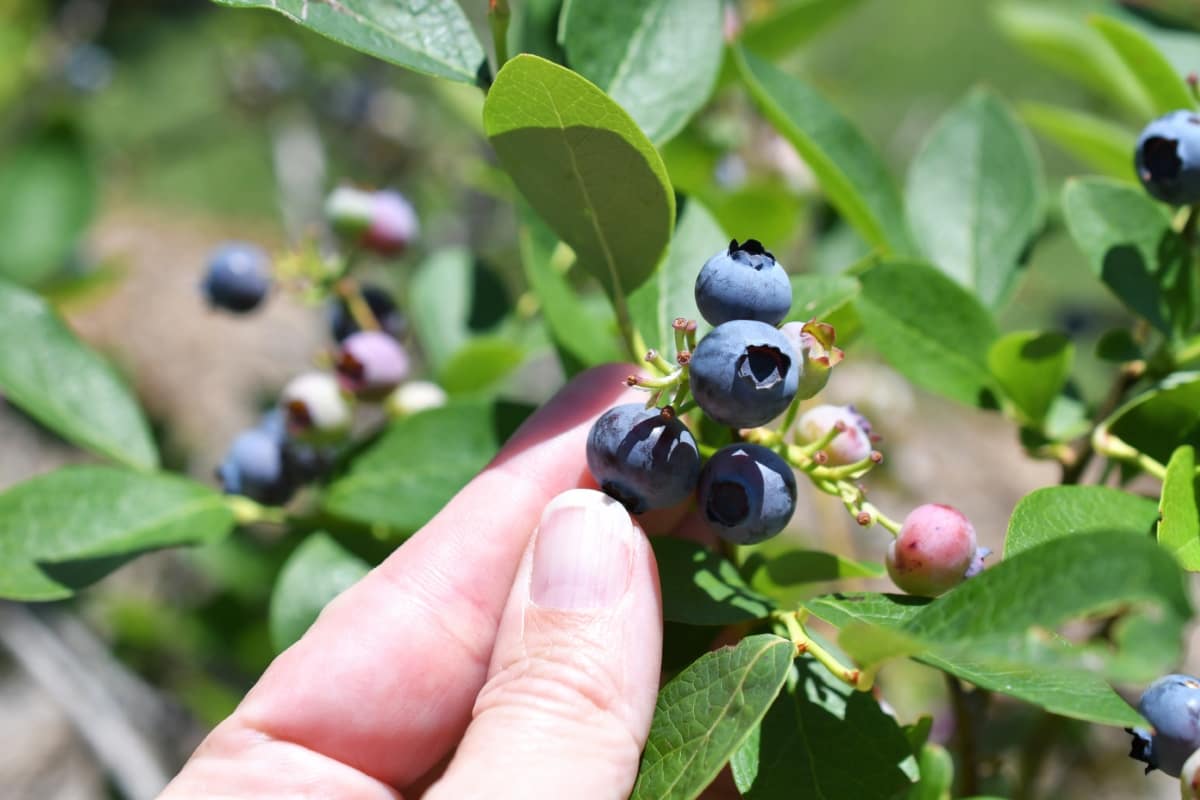Keeping your blueberry plant healthy and producing delicious fruit requires fertilizing. When applying fertilizers, however, you should follow some guidelines. Blueberries are sensitive to overfertilization, and their nutrient requirements are lower than those of row crops and vegetables.

In acidic soils, where nutrient availability is extremely restricted, blueberry species evolved under the canopy of coniferous forests. This is why overfertilization can lead to salt burn to the roots, observed as shoot dieback and leaf scorching. The following guide will explain how to fertilize blueberries to prevent excess nutrient applications while maintaining adequate plant growth and yield.
Best Fertilizer for Blueberries
Type of Fertilizers Need to Be Used for Blueberry Bushes
Blueberry fertilizer can be divided into three types. One blueberry fertilizer works solely to lower the soil’s pH into the target range, another adds nutrients without altering the pH, and a third blueberry fertilizer is a combination of both acidifying the soil pH and adding nutrients. We’ll discuss them one by one.
Blueberry Fertilizer to Acidify the Soil
If your soil pH is too alkaline and needs to be acidified, but your nutrient content is fine, these are the products to use.
- Ammonium sulfate: For ensuring the soil remains acidic, ammonium sulfate is the most commonly recommended fertilizer for blueberries. Your soil’s acidity determines how much you need to apply initially. Applying between 50 and 100 grams of fertilizer per bush yearly is typically sufficient to maintain a pH between 4.5 and 5.1.
- Elemental sulfur: It’s a relatively slow-acting product, so soil microbes need time to process it and produce an effective pH change. However, root burning or overfertilization is much less likely when using ammonium sulfate. According to the USDA’s National Organic Standards Program, it can be used for organic farming. The soil test results will determine how much is best for your soil.
Blueberry Fertilizer to Add Nutrients
You will only need to provide nutrients if your soil test shows nutrient deficiencies, not alter the pH if your soil pH is within the target range. Fertilizers containing a large amount of nitrogen damage young blueberries (they are sensitive to synthetic fertilizers). Nitrates and chlorides should be avoided in fertilizers.
It is best to provide blueberries with slow-release nitrogen. Granular organic fertilizers with nitrogen (N), phosphorus (P), potassium (K), and micronutrients are particularly beneficial. The synthetic product urea is often promoted as a nitrogen source but is not approved for use on organic farms.
Blueberry Fertilizer Acidifies the Soil and Adds Nutrients
The best blueberry fertilizer is a combination fertilizer that acidifies the soil and adds nutrients simultaneously. Using fertilizers intended for acid-loving plants such as rhododendrons, azaleas, hollies, and other evergreens is best. As well as being safe for soil microbes, Holly-tone contains nitrogen, potassium, phosphorous, calcium, magnesium, and other elements, along with elemental sulfur, which acidifies the soil.
In case you missed it: Hydroponic Blueberry Farming in a Greenhouse: Key Rules to Start from Scratch

It is a favorite fertilizer brand. Natural ingredients include feather meal, poultry manure, alfalfa meal, and elemental sulfur. Unless your soil pH is extremely alkaline, you do not need to add a sulfur fertilizer.
When to Fertilize Blueberries Bushes
When it comes to fertilization, blueberries have different needs. Plant growth and fruit development determine the timing of fertilizer applications. Blueberries will respond well to small amounts of fertilizer applied three times in three different areas of the soil, regardless of whether you are adjusting the soil pH or adding nutrients.
The first dose of fertilizer for blueberries should be applied early in the season. For this application to work properly, it must be applied right before or as soon as the bushes begin to leaf out. As a result, the bush produces strong foliage and can store more energy for flower production.
Strong early growth is essential to setting the stage for strong blooming; there is no doubt about that. The early dose of power sets the tone for everything to come. The second application of granular fertilizer should be done six to eight weeks after the first application. During this burst of energy, the bush can replenish all the nutrients it has used to prepare for fruiting. At this point, powering the bush will increase production and yields.
The third and final boost of fertilizer should be applied to your bushes after they finish producing. The bush needs additional nourishment to replace the energy used during fruiting. This application is vital and is usually the one that is overlooked most often. Despite not producing more berries, the third dose allows the bush to recover and store energy for the following season. The next year’s production levels will not be as fruitful without it.
Best Way to Apply Fertilizer for Blueberry Bushes
Blueberries absorb nutrients through their roots. Start by gently raking the soil around each plant in a circle. Make sure not to rake deeply so as not to damage the roots. Instead, simply loosen the soil surface so that fertilizer can be incorporated. Fertilizer should be applied uniformly around the plant’s drip line, one foot outward, but never near the base.
You should avoid getting fertilizer on the foliage or against the bark because this can cause damage. In the event that fertilizer does come into contact with leaves, brush it away as soon as possible. Spread the fertilizer over the soil, gently rake it, and then water it so the plants can absorb it.
A balanced organic granular fertilizer containing ingredients such as blood meal, seaweed, bone meal, potash, etc., will supply your blueberries with adequate nitrogen (N), phosphorus(P), potassium(K), and micronutrients such as zinc (Zn), calcium (Ca), magnesium (Mg), manganese (Mn), copper (Cu), and others. You should apply 1/4 – 1/2 cups of fertilizer annually to blueberry plants in their second and third years. Adding 2 to 3 cups of nutrients per bush per year is recommended for mature, full-sized blueberry bushes.
Mulching Blueberries After Fertilizing is a Good Idea?
Blueberry roots benefit from mulching because it insulates them, stabilizes soil temperatures around them, and reduces weeds. Due to their shallow root systems, don’t go overboard with the mulch, or you’ll smother them. The land is covered with one to two inches of pine straw, wood chips, or shredded leaves. You can add it to the fertilizer if you’d like. The fertilizer can also be applied directly to the mulch. It’s a good choice either way.
In case you missed it: How to Start Blueberry Farming in the USA: A Step-By-Step Production Guide

Conclusion
Eating homegrown blueberries straight off the bush or adding them to pies, muffins, and other baked goods is delicious. Since most growers fertilize blueberry bushes only a few times yearly, growing blueberries is a relatively low-maintenance task. It is essential to pick the right fertilizer for blueberry plants to thrive.
- Feed Your Flock for Less: Top 10 Tips to Save on Chicken Feed
- Ultimate Guide to Ossabaw Island Hog: Breeding, Raising, Diet, and Care
- Hatching Answers: The Top 10 Reasons Your Chickens Aren’t Laying Eggs
- Eggs and Economics: Breaking Down the Cost of Raising Backyard Chickens
- Defend Your Greens: Proven Methods to Keep Iguanas Out of Your Garden
- Ultimate Guide to Cinnamon Queen Chicken: A Comprehensive Guide for Beginners
- Ultimate Guide to California Tan Chicken: Breeding, Raising, Diet, Egg-Production and Care
- Ultimate Guide to Marsh Daisy Chicken: Breeding, Raising, Diet, and Care
- 10 Types of Chicken Farming Businesses You Can Start for Profits